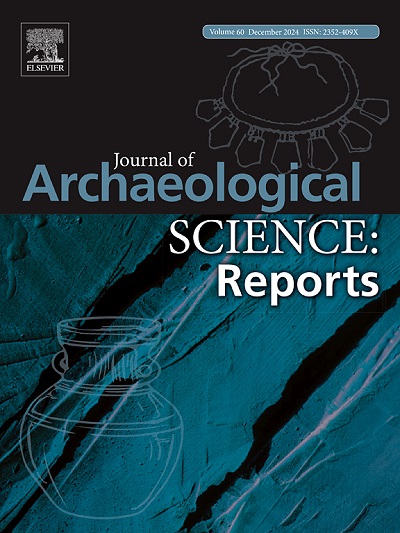Interregional networks in the late Viking Age? Insights from a burned pit house in the Viking-Age town of Aros, present-day Aarhus, Denmark (ca. 980 CE)
IF 1.5
2区 历史学
0 ARCHAEOLOGY
引用次数: 0
Abstract
The Viking Age was a dynamic period, with local centres and urban sites engaging to varying degrees in local, regional and interregional networks. While the role of certain northern towns in these networks is relatively well-known and the related knowledge up to date, other towns appear to have received comparatively little recent attention. This study aims to investigate the role of the Viking-Age town of Aros, present-day Aarhus, situated on the eastern coast of Jutland, Denmark, in interregional networks, by means of the interdisciplinary study of a rare context, excavated in 2009: a well-preserved burned pit house at the site of Bispetorv, dated to the late 10th century CE. What does the archaeological assemblage tell about the house and its occupants, what can be said about resource exploitation, and to what extent were the occupants of the late Viking-Age pit house involved in long-distance trade?
The study of the pit house at Bispetorv is based on an interdisciplinary approach, including analysis of inorganic artefacts, zooarchaeological remains, macrobotanical remains and carbonised wood collected from multiple layers, supported by a substantial number of radiocarbon dates. The outcomes are presented within the framework of other comparable published and unpublished sites in and nearby Aarhus including Søndervold and Skt. Clemens Stræde, as well as with other Viking-Age towns in northern Europe.
The analysis of Bispetorv reveals a predominance of artefacts and ecofacts associated with regional networks, with scant evidence of contacts with the Baltic Sea coast. While these results match the findings from other sites in Aarhus, and are comparable to other local centres, they are in apparent contrast to larger urban centres such as Ribe, Hedeby and Kaupang. Further research, based on a variety of methods, will have to show to what degree the currently available bioarchaeological results from Aarhus are representative for the remaining parts of the urban centre and to what extent long-distance contacts evolved over time.
维京时代晚期的地区间网络?从维京时代的阿罗斯镇,即今天的丹麦奥胡斯(约公元980年)一座被烧毁的坑屋中看到的景象
维京时代是一个充满活力的时期,地方中心和城市遗址在不同程度上参与了地方、区域和区域间的网络。虽然某些北方城镇在这些网络中的作用是比较众所周知的,有关的知识也是最新的,但其他城镇最近似乎很少受到注意。本研究旨在通过对2009年发掘的罕见背景的跨学科研究,调查位于丹麦日德兰半岛东海岸的维京时代小镇Aros,即今天的奥胡斯,在区域间网络中的作用:比斯佩托夫遗址保存完好的燃烧坑屋,可追溯到公元10世纪后期。考古组合告诉我们关于房子和它的居住者的什么,关于资源开发可以说些什么,以及维京时代晚期坑屋的居住者在多大程度上参与了长途贸易?对Bispetorv坑屋的研究是基于跨学科的方法,包括分析无机人工制品、动物考古遗迹、宏观植物遗迹和从多层收集的碳化木材,并得到大量放射性碳测年的支持。研究结果是在奥胡斯及其附近其他可比较的已发表和未发表的网站的框架内提出的,包括Søndervold和Skt。克莱门斯特æde,以及北欧其他维京时代的城镇。对比斯佩托夫的分析显示,与区域网络相关的人工制品和生态事实占主导地位,与波罗的海沿岸接触的证据很少。虽然这些结果与奥胡斯其他地点的发现相吻合,并且与其他当地中心相当,但它们与Ribe, Hedeby和Kaupang等较大的城市中心形成明显对比。基于各种方法的进一步研究将必须表明,目前从奥胡斯获得的生物考古结果在多大程度上代表了城市中心的其余部分,以及远距离接触在多大程度上随着时间的推移而发展。
本文章由计算机程序翻译,如有差异,请以英文原文为准。
求助全文
约1分钟内获得全文
求助全文
来源期刊

Journal of Archaeological Science-Reports
ARCHAEOLOGY-
CiteScore
3.10
自引率
12.50%
发文量
405
期刊介绍:
Journal of Archaeological Science: Reports is aimed at archaeologists and scientists engaged with the application of scientific techniques and methodologies to all areas of archaeology. The journal focuses on the results of the application of scientific methods to archaeological problems and debates. It will provide a forum for reviews and scientific debate of issues in scientific archaeology and their impact in the wider subject. Journal of Archaeological Science: Reports will publish papers of excellent archaeological science, with regional or wider interest. This will include case studies, reviews and short papers where an established scientific technique sheds light on archaeological questions and debates.
 求助内容:
求助内容: 应助结果提醒方式:
应助结果提醒方式:


